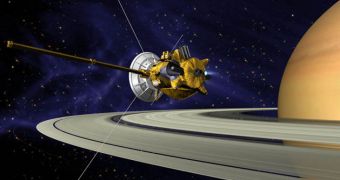Officials at the NASA Jet Propulsion Laboratory (JPL), in Pasadena, California, announced yesterday, September 27, that the Cassini spacecraft has begun a new phase in its extended mission.
Experts here, who manage the mission for NASA's Science Mission Directorate, in Washington DC, say that this new stage is called the Cassini Solstice Mission.
The new mission extension will last until September 2017, and will follow the gas giant's northern summer solstice for a few Saturnine months.
The main point of this extension is to assess long-term weather and seasonal variations that may take place on the planet. Due to its distance from the Sun, a year on Saturn lasts for about 30 Earth years.
“After nearly seven years in transit and six years in Saturn orbit, this spacecraft still just hums along. With seven more years to go, the science should be just as exciting as what we've seen so far,” says Bob Mitchell.
The expert, who is based at the JPL, is the program manager for the Cassini orbiter. The spacecraft is a component of the Cassini-Huygens mission, developed by NASA, ESA and the Italian Space Agency.
Since its arrival at Saturn, the spacecraft has performed a series of flybys of numerous Saturnine moons, providing its JPL controllers with massive amounts of new data on a variety of topics.
Its suite of instruments is capable of surveying target bodies in a variety of wavelengths, and its cameras are capable of making out fine details with incredible accuracy.
The radars Cassini has can pierce through the cloud banks that cover the surface of Titan, the gas giant's largest moon, and observe its lakes of liquid hydrocarbons.
Additionally, the orbiter managed to conduct impressive observations of the moon Enceladus, which astronomers believe contains a huge liquid ocean, submerged under tens of miles of ice.
“The Cassini Solstice Mission will enable continued study of these intriguing worlds. It will also allow scientists to continue observations of Saturn's rings and the magnetic bubble around the planet, known as the magnetosphere,” JPL experts say in a press release.
“Near the end of the mission, the spacecraft will make repeated dives between Saturn and its rings to obtain in-depth knowledge of the gas giant. During these dives, the spacecraft will study the internal structure of Saturn, its magnetic fluctuations and ring mass,” they go on to say.
At this point, Cassini is considered to be one of the most important robotic space exploration mission, next to the rovers Spirit and Opportunity, and the orbiters Mars Odyssey, Mars Reconnaissance Orbiter (MRO), and Lunar Reconnaissance Orbiter (LRO).

 14 DAY TRIAL //
14 DAY TRIAL //